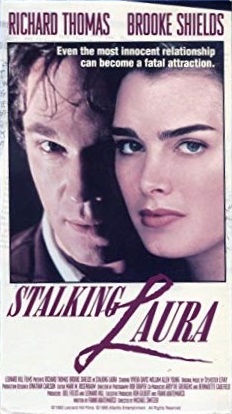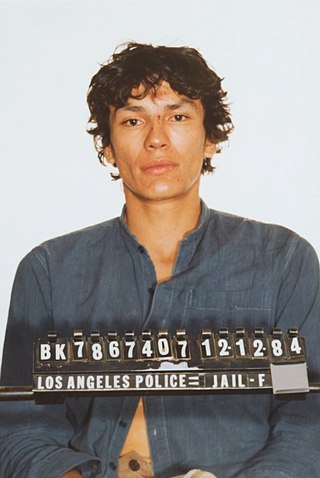
George Lester Jackson was an American author, activist and convicted felon. While serving an indeterminate sentence for stealing $70 from a gas station in 1961, Jackson became involved in revolutionary activity and co-founded the prison gang Black Guerrilla Family.

San Quentin Rehabilitation Center (SQ), formerly known as San Quentin State Prison, is a California Department of Corrections and Rehabilitation state prison for men, located north of San Francisco in the unincorporated place of San Quentin in Marin County.

The Mexican Mafia, also known as La eMe, is a Mexican American criminal organization in the United States. Despite its name, the Mexican Mafia has no origins in Mexico, and is entirely a U.S. criminal prison organization. Law enforcement officials report that the Mexican Mafia is the deadliest and most powerful gang within the California prison system.

Matricide is the act of killing one's own mother.

Clarence Ray Allen was an American criminal and proxy killer who was executed in 2006 at the age of 76 by lethal injection at San Quentin State Prison in California for the murders of three people. Allen was the second-oldest inmate at the time to be executed in the United States since 1976.
ESL Incorporated, or Electromagnetic Systems Laboratory, was a subsidiary of TRW, a high technology firm in the United States that was engaged in software design, systems analysis and hardware development for the strategic reconnaissance marketplace. Founded in January 1964 in Palo Alto, California, the company was initially entirely privately capitalized by its employees. One of the company founders and original chief executive was William J. Perry, who eventually became United States Secretary of Defense under President Bill Clinton. Another company founder was Joe Edwin Armstrong. ESL was a leader in developing strategic signal processing systems and a prominent supplier of tactical reconnaissance and direction-finding systems to the U. S. military. These systems provided integrated real-time intelligence.
The Soledad Brothers were three inmates charged with the murder of a prison guard, John Vincent Mills, at California's Soledad Prison on January 16, 1970. George Jackson, Fleeta Drumgo, and John Clutchette were alleged to have murdered Mills in retaliation for the shooting deaths of three black prisoners during a prison fight in the exercise yard three days prior by another guard, Opie G. Miller. Clutchette and Drumgo were acquitted by a jury while Jackson was killed in a prison riot prior to trial.
Ruben Grijalva is a former director of the California Department of Forestry and Fire Protection, appointed in 2006. He received some media attention during the California wildfires of October 2007. In one press report, he asserted that state agencies had done all they could to send useful resources to battle the wildfires. He resigned from the position in February 2009 and went to work as a private consultant.
The San Quentin Six were six inmates at San Quentin State Prison in the U.S. state of California who were charged with actions related to an August 21, 1971 escape attempt that resulted in six deaths and at least two people seriously wounded. The San Quentin Six were Fleeta Drumgo, David Johnson, Hugo Pinell, Johnny Larry Spain, Willie Tate, and Luis Talamantez. The dead included George Jackson, a co-founder of the Black Guerrilla Family; two other inmates, and three guards.
The Bethel Regional High School shooting was a school shooting that occurred on February 19, 1997, at Bethel Regional High School in Bethel, Alaska. Two people were killed and two people were wounded by 16-year-old student Evan Ramsey. Ramsey is serving two 99-year prison sentences and will be eligible for parole in 2066 when he is 85.
The Lindhurst High School shooting was a school shooting and subsequent siege that occurred on May 1, 1992, at Lindhurst High School in Olivehurst, California, United States. The gunman, 20-year-old Eric Houston, was a former student at Lindhurst High School. Houston killed three students and one teacher and wounded nine students and a teacher before surrendering to police. Houston was sentenced to death for the murders, and he is currently on California's death row in San Quentin State Prison.

M. Gerald Schwartzbach is an American criminal defense attorney.

I Can Make You Love Me, also known as Stalking Laura, is an American 1993 made-for-television psychological thriller film starring Richard Thomas and Brooke Shields. The film is based on the real-life story of American mass murderer Richard Farley, a former employee of ESL Incorporated whose romantic obsession and subsequent stalking of co-worker Laura Black culminated in the mass murder of several co-workers at ESL's headquarters in California, resulting in the first anti-stalking laws to be enacted in the United States.
The Marin County Civic Center attacks were two related attacks in 1970 at the Marin County Civic Center courtroom in San Rafael, California, United States, tied to escalating racial tensions in the state's criminal justice system.

William Ray Bonner is a former service station attendant who went on a shooting spree through the South Side area of Los Angeles, California, on April 22, 1973, killing six people and wounding nine others. The rampage ended with his arrest after he had been injured in a shootout with police.

Ricardo Leyva Muñoz Ramirez, known as Richard Ramirez, dubbed the Night Stalker, the Walk-In Killer and the Valley Intruder, was an American serial killer and sex offender whose crime spree took place in California from June 1984 until his capture in August 1985. He was convicted and sentenced to death in 1989, and died while awaiting execution in 2013.

On June 7, 2013, a spree shooting occurred in Santa Monica, California. Its catalyst was a domestic dispute and subsequent fire at a home, followed by a series of shootings near and on the Santa Monica College campus. Six people were killed, including the suspect, and four injured. The shooter — 23-year-old John Zawahri — was killed by police officers when he exchanged gunfire with them at the Santa Monica College library.
Alexander Hernandez is an American serial killer who murdered five people during a series of drive-by shootings in the Los Angeles Metropolitan area of California between March and August 2014. He targeted random people and dogs, murdering five people, injuring 11 others, and killing two dogs. He was later convicted of the crimes and sentenced to life imprisonment without the possibility of parole.










